Geoff Nicholson's Blog, page 3
July 8, 2024
DRIFTING WITH WITH DEAKIN
I’ve been reading Iain Sinclair’s Pariah Genius, his ‘psychobiography’ – partly fictionalized - of John Deakin, in which he ‘follows in the footsteps of the famed Soho photographer. kept man, primitive painter and secret witness.’ I’m quoting from the blub there as you probably guessed.

The writing’s great of course – it’s by Iain Sinclair, but it’s not a pacey read. The problem I personally may have with it, is that I’m not all that fascinated by the gilded seamy glamour of Soho, the much recorded nexus of Lucian Freud, Francis Bacon, Daniel Farson, Muriel Belcher, the Colony Club, the French House, all the booze and the gay sex with dodgy geezers, some of them in scarily sharp suits. And it seems to me that Sinclair isn’t entirely fascinated either, though I’m sure both he and I have done our miles pounding the streets of Soho.
The book picks up a lot of energy when Deakin, because of Bacon, becomes an habitué of Limehouse where he ‘walked. Alone. Uncommissioned. His patrons, the indulgent editors, had no part in this.’ The section is titled ‘Deakin as Psychogeographer,’ and Limehouse is Sinclair territory too - see Ludheat - and so he can walk the same streets as Deacon, and many others. Some of Deakin’s archive can be seen on Instagram.

Sinclair mentions the photographer and ‘compulsive pedestrian’ Harry Diamond, who sometimes modeled for Lucian Freud. Sinclair writes, ‘The lengthy sessions Freud demanded interrupted his (Harry D’s) eternal stamping across London. … Harry had no use for taxis. He knew that blisters were the surest route to Enlightenment.’ Somebody not me, should have that tattooed across their instep. This is a self-portrait of Harry Diamond in Brick Lane in 1973.

There is no doubt a mighty book to be written about photographers who walk and walkers who take photographs, though how would the poor author ever be able to afford to pay for the use of the images? We might quote Julio Cortazar, as Sinclair does, ‘But in all the ways when one is walking about with a camera, one has almost a duty to be attentive, to not that lose that adrupt and happy rebound of sun’s rays off an old stone.’
I don’t understand why it’s almost a duty rather than entirely a duty, but maybe it loses something in the translation.
July 4, 2024
VOTING WITH MY FEET

I walked up the hill to the polling station yesterday to cast my vote and participate in the democratic process.

This wasn’t any kind of politically-motivated derive, but it was a nice day, I felt like a walk, and perhaps the greatest motivation of all, I thought it might be a bugger to park near the polling station.

The walk was fine, the polling station was fine, the polling clerks were very friendly and helpful and good humoured. However, that was at 10 in the morning, and I imagine their humour might have faded somewhat by 10 at night. And so I presented my photo ID, was given a ballot paper, put my cross in a box on the paper, and put the paper in a plastic box. My civil duty was done.
And the parking?
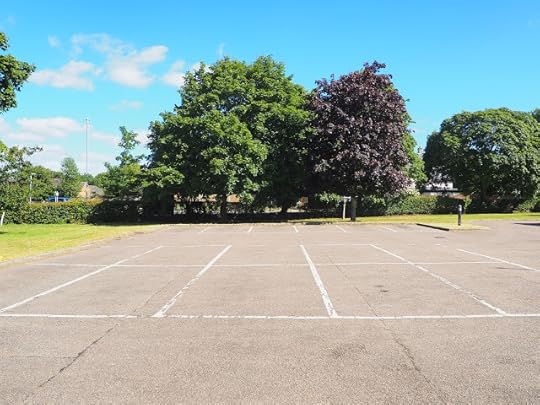
Well of course there was enough room to park a bus, several buses, several battle buses.


I walked down the hill again, to await the tsunami.

July 2, 2024
TRAILING IN HARLOW

One of the best reasons for spending a Saturday night in the Holiday Inn Express in Harlow is that come the next morning you can have a meander round the Market Square and the Broad Walk.
You could, and we sort of did, walk around it on Saturday night, but there was a certain amount of police activity which in an unknown town rather deters the casual boulevardier. Come the morning at about 9 am the place was all but deserted, although by ten it was starting to get busy, though not in a ‘police activity’ kind of way, just people on their way to Gregg’s, Primark and to the many barbers, and on the way strolling past quite a few closed down establishments.

Such a walk, inescapably, covers part of the Harwich Sculpture Trail. There are pieces of sculpture around the town, including a Henry Moore and a Rodin, though we by no means saw them all.
The sculptures we saw were great; Meat Porters by Ralph Brown, 1959
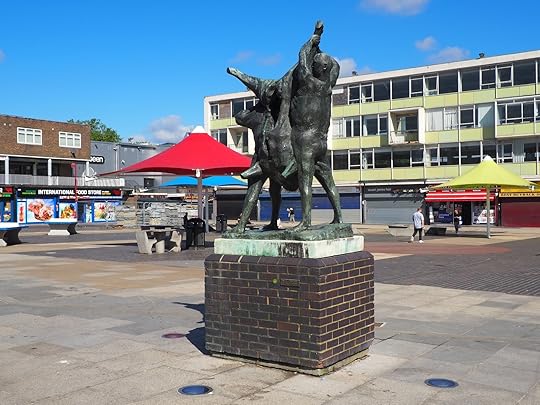
Trigon, by Lynn Chadwick, 1961

Vertex, by Paul Mason 1979

But for a man with my specialist enthusiasms they all rather fell by the wayside compared with this fine obelisk, possibly a quasi or broken obelisk by Sir Frederick Gibberd, who was one of the chief begetters of Harlow New Town, as well as architect of the London Central Mosque and the Liverpool Metropolitan Cathedral.
We also got a look at the bus station, and at Terminus House, which I thought looked all right from the outside, though according to the BBC it’s a ‘Human Warehouse,’ formerly an office block, and now hot bed of drugs and sex crime: we had to take their word for it.

This is Sir Frederick Gibberd in life:
and in sculpture:

June 24, 2024
THE MOORE THE MERRIER
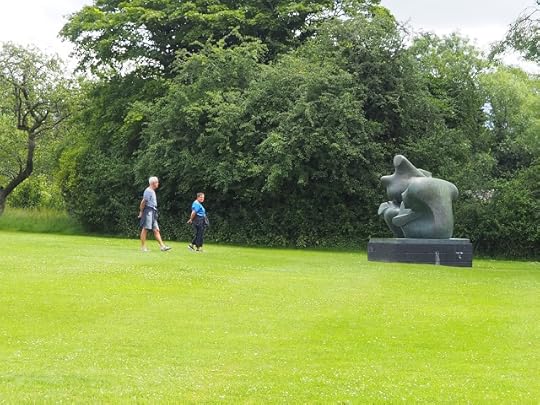
Here’s a psychogeographic project for some bright, fit, young soul who’s got a private income and lots of time on their hands. Why not walk to, between, and around, every Henry Moore sculpture in the world? Here’s a map from the Henry Moore Foundation of ‘works in public’ that gives some sense of the task.

If you wanted to restrict yourself to just the ones in Britain it would be reasonably doable, though not a walk in the park.

Japan, with a short side excursion to South Korea, would make a fine project too.

Africa needn’t trouble you much, and Russia not at all.
These thoughts are inspired, if that’s the word, by a visit to the Henry Moore Studios and Gardens, (also his house Hoglands) at Perry Green in Hertfordshire. There are 70 are acres of land with 21 major works by Moore scattered across them. The sculptures are different sizes of course, but none of them is small, and some of them are absolutely massive.
70 acres provides scope for plenty of walking. The main area that visitors go to is called the sculpture lawn, then there’s a meadow and a large area designated as ‘sheep field,’ complete with sheep. In the outer reaches of the site, the sculpture thins out considerably, and I'm sure that’s the way Moore wanted it.

Perhaps the best thing about the gardens is how few paths there are. There are one or two, but mostly you’re free to walk where you like, make your own way, plan your own route across grassy expanses, and see the sculptures in any order you like, from any angle, from as near or as far as you like. You can even touch them, so long as you’re gentle and you don’t climb on them or their plinths.
In general there was plenty of information at the place but there was one thing I didn’t manage to find out. Was Henry Moore a walker? He grew up in Castleford in Yorkshire, which is near some very good walking territory, and I take it that if you own 70 acres you’re going to do some walking one way or another.
We know that he liked his sculptures to be placed and seen in the great outdoors, and there are plenty of pictures of him posing with them in wide open spaces, but I haven’t been able to find any pictures of him walking. I imagine they do exist.
And I think it’s reasonable to wonder if he said ever to his wife Irina, ‘All right love, I’m just going for a walk round the garden,’ and then she wouldn’t see him for a few hours. More research required. I’m working on it.
June 20, 2024
WALKING WORDS
I do love a good concordance.
In Mike Bonsall’s majestic concordance of JG Ballard you’ll discover that the sage of Shepperton used the word walk and its derivatives well over 500 times in his fiction. I’m somehow glad to know that.
Examples:
I was walking down Shepperton High Street on my way to the shops
The psychiatrist was walking towards the pool with a dry towel.
Do you mind walking me back to the elevator? It must sound rather paranoid
I actually saw a unicorn walking on the water, its hooves shod in gold.
And so on.
https://bonsall-books.co.uk/concordance/index.htm
And now I discover a website called The Flickering Lexicon, which has a concordance of Fall lyrics, mostly by Mark E Smith I assume. Did he let anybody else get a word in?
The scores are as follows
walk - 60
walked - 11
walks - 40
walking -48
there’s one walkin, one walkmans, and one walkman’d
I do like ‘walkman’d’ – I’m not sure I’ve ever seen it anywhere else.
Examples:
I was walking down the street when I tripped up on a discarded banana skin
Watch out for the lorries as you walk in the gate
You don't see rabbits being walked down the street
They are walking with M&S bags, doing the jingle bell
Hands up Billy you're walking in a crutch, yeah
 Photographer unknown, at least to me.
Photographer unknown, at least to me.
https://dannyno.org.uk/fall/w.htm
*
I’m not sure that either Ballard or Smith were great walkers but so what? The words are there, in the texts, in the literature. That’s where it really matters.
JGB photo – Fay Godwin
Photographer unknown, at least to me.
Of course it’s not every author who merits a concordance (no, I’m not bitter, and yes I suppose you probably have to be dead) and even when they exist they may be done by individual titles rather than complete works, so I can’t give you the complete countdown for the whole of Virginia Woolf, but thanks to victorian-studies.net I can for Mrs Dallowayoften regarded as the crème de la crème of flaneuse fiction. It has just 12 uses of walk, but 25 walking 25, 25 walked, 1 walks.
Example:
Yes, he remembered Regent's Park; the long straight walk; the little house where one bought air-balls to the left.
I don’t really know what an air-ball is. Could it be this kind of thing?

June 11, 2024
JUST ONE WALK
Over the weekend I was thinking about two very different walkers, the first a lesser known character name of Konstantin Schoen, a fireman from Manningtree in Essex who’s in the middle of doing a 400 mile walk around all the fire stations of Essex – there are 51 of them, apparently - raising money for Fire Fighters Charity.

He looks like a nice lad, though with a slightly unusual biography. He’s only 26, he comes from Hessen in Germany, and moved to London in 2017 then to Manningtree in 2023. There can’t be many young Germans who do that.
He was quoted in the Gazette News as saying ‘the only challenge I’ve had so far has been predicting what the weather is going to be like,’ and also that he’s been ‘knee deep in mud and water.’ Well yes, welcome to Essex, and good for you Konstantin, but you know there are worse walking problems, as poor Dr Michael Mosley found out.

I only knew Michael Mosley as the host of the radio programme ‘Just One Thing’ which at one level proposes an incredibly attractive idea,that we could all improve our lives and health by making just one small adjustment. However, since the show ran to a hundred and some episodes it sounded as though he really wanted us to change just about everything.
A few of these adjustments did in fact involve walking and/or changing the way we walked. One suggestion was that you could burn more calories and boost your heart health by walking with Nordic poles, another advised walking backwards, another recommended going out for a walk after rainfall, another said go for a walk early in the morning. Well OK, sure, but …

And then Michael Mosley went missing, having set off on a walk from Agios Nikolaos beach (spellings vary) heading for the port of Symi on the Greek island of the same name, although apparently he intended to take a bus part of the way.
However, a) he’d told his friends he wasn’t feeling well, b) the temperature was around 100 degrees F, and c) he got lost. This map may explain some of it:
As is now well known, he went missing and after a five day search he was found dead just yards away from the probable safety of the Agia Marina Resort. The autopsy concluded that he collapsed and died of heat stroke and exhaustion some two and a half hours after he’d set off.
I think most of us who are even vaguely serious about walking sometimes feel unexpectedly exhausted when in mid-walk, and it does cross our minds that we might collapse and die in media res. There are worse ways to go, I suppose if you're a walker. But when you’re on a holiday island only yards from a bar, where presumably somebody might know first aid, well that just doesn’t seem right or fair, does it? Poor Michael Mosley. Poor Michael Mosley’s family. Some things, we know, are unchangeable.
May 28, 2024
BLISSFUL WALKING
I was once ‘in conversation’ with Will Self for The Believer magazine, and I mentioned something that Edmund White says in his book The Flaneur, that in Paris heterosexuals cruise each other the same way that homosexuals do.
This didn’t sound very likely to me though I was in no position to argue, and I offered the opinion to Will Self, that to a boring old heterosexual such as myself, gay cruising sounded like really hard work, a series of complex negotiations involving body language, dress codes, posing, eye contact and what not, all done while walking.
Will Self, naturally, disagreed, ‘I think it sounds like enormous fun … Go out, have a walk, and score. Bliss!’
Well, bliss is a lot to ask of any walk, and I don’t think there’s any such thing as a ‘perfect walk’ but a week or two back I was walking, with others (hi there Mel, Marianne, Caroline) in Hadleigh Country Park, right here in Essex, and it was very fine indeed.
I think none of us was in the mood for a major expedition, I certainly wasn’t – we’d had a good lunch - and I wasn’t expecting too much from this walk, but it occurs to me now that perhaps one of the secrets of a good walk is to have no expectations: – not low expectations, but none at all, which is to say that in this case I had very little idea what I was in for, which was good.
Hadleigh Country Park is a 387 acre patch, that gives you a view of the Thames Estuary, Hadleigh Castle, and even, and for me this was wonderful – Southend Pier, that’s the distant white rectangle you can just about see in the far distance. I thought this was fantastic.
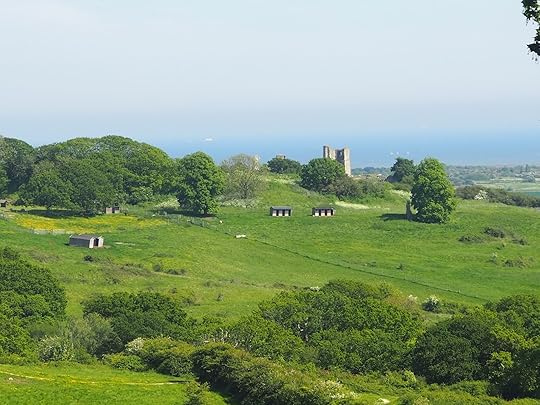
The Park was also the venue for the 2012 Olympic Mountain biking course, and the bike tracks remain though on the day we were there bikers were few and far between, which was how we liked it.
Today there’s also a glamping facility, and apparently there are roaming cows, none of which we crossed paths with, though there was much fecal evidence of where they’d been. There was also this somewhat Magritte-ish door which I’d guess (and I am only guessing) was once part of a kids’ adventure playground, though it’s now kept locked – probably something to do with health and safety.
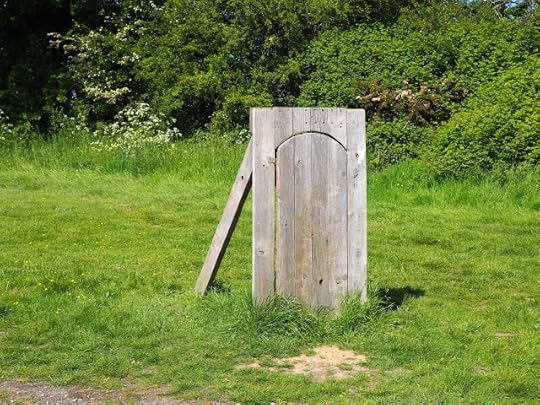
And best of all there were world war two bunkers. I do love a good bunker or pillbox or related buildings, and of course the Thames Estuary was a place that really needed them during hostilities. In this case you could get right up close and personal, and even look right inside. I'd had no idea.
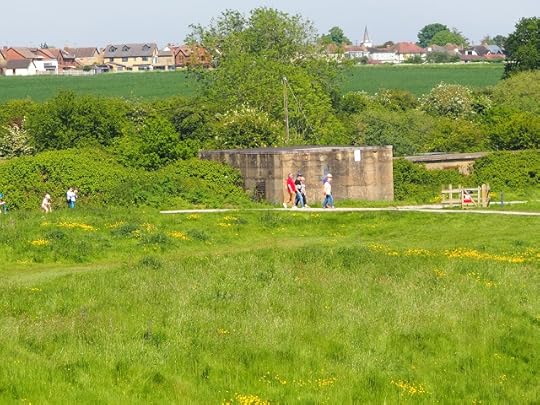
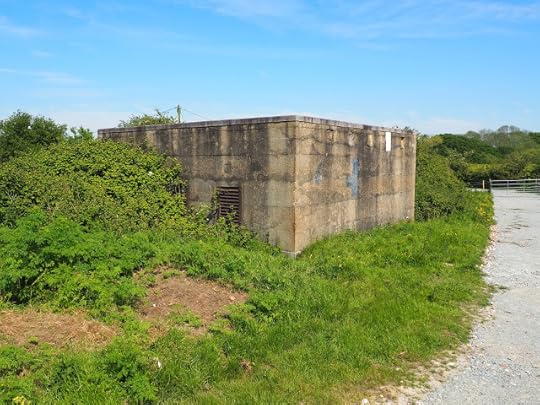

Does this count as bliss? No, probably not, but it occurred to me, towards the end of our Hadleigh excursion, that if a walk doesn’t involve sex (and our certainly didn’t), the next best thing is probably a bunker.
May 23, 2024
WET WALKING

I often say that the whole point of walking is that you get out there and you see things that you wouldn’t see if you weren’t on foot, or you see old things in a new way. I’ll happily stand by that as a principle, but I’ve recently done a couple of not quite local walks here in Essex which make me wonder if in fact, however lofty your ideals, however pure your intentions, you often end up seeing and noticing the same old same old.
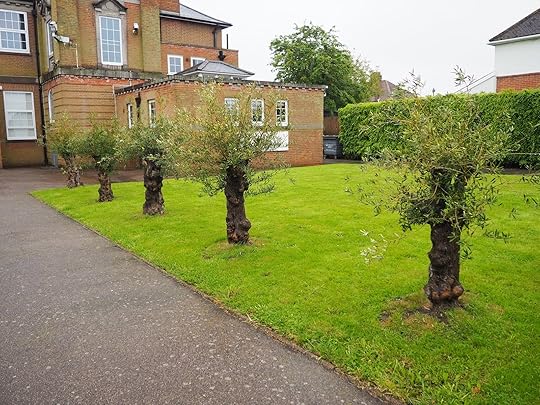
The first of these walks was from Dovercourt train station to the Fryatt hospital, which is officially in Harwich, at most a 25 minute walk. I was going along to the hospital for some specialized blood test that apparently couldn’t be done in my own doctor’s surgery. I hoped this test itself would take about five minutes, which it did, and so I’d have time to do some drifting.
The only problem was that it was absolutely pissing down on the day I went, and so I hurried along there and back, not noticing as much as I’d have liked to because my head was down, my shoulders were hunched, my cap was partly over my eyes, as I careered down the street trying to minimize my soaking.
But I wasn’t completely in my own cocoon. I spotted some of the things I always like to spot, such as blank notice boards:
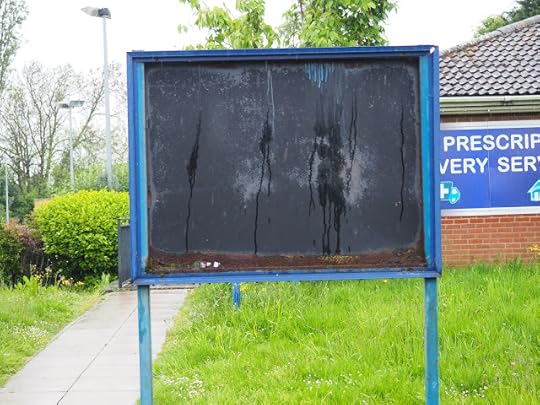
cars in the wilderness:

These are the kind of things I always enjoy noticing, but just lately, the architectural noticer in me, has been starting to look at external staircases, which are often, though not always, fire escapes. Like this one:

If it hadn’t been for the rain I’d have walked further, looked around more, seen more, photographed more, but a pedestrian has to play the hand they’re given. I didn’t mind getting a bit wet but I didn’t want to be soaked to the edge of pneumonia. But in some small mitigation I did see, in somebody’s front garden, getting far more soaked than I was, this quite comfy looking chair – that felt like something I’d never really looked at properly before:
Then, less than a week later, I was walking in Chelmsford, and it was raining again, though not nearly as hard as it had been in Dovercourt. And yes, some of my small obsessions were catered for, an obelisk of sorts by the cathedral:
a bench, proclaiming its place of residence:
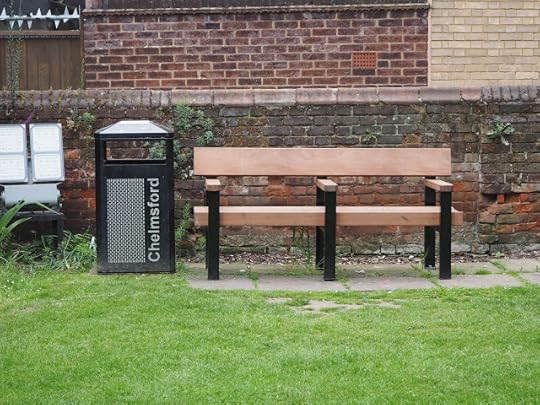
some topiary, an interest I’ve recently picked up from my other half:
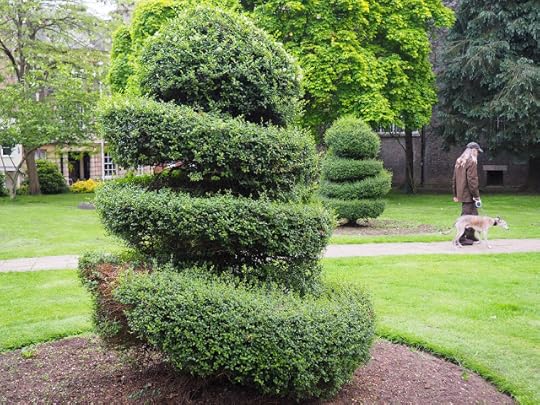
another fire escape:

And so on. And this I think is my point, you look at the same old things, you have the same old interests and obsessions, but they do change, or change their intensity, over time. For instance there was a show at the Gareth Gardner Gallery, photographs of hedges. Now I have always noticed hedges and taken the occasional photograph, but now I find I REALLY notice them. Such as this one in Chelmsford:
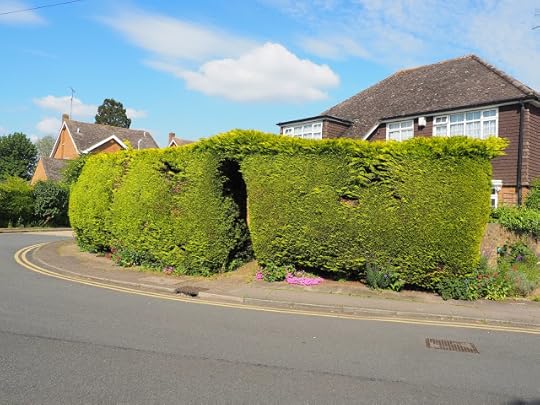
And the thing is, I don’t really expect anybody else to be interested in the things that I am. I mean, I write this blog, I publish the occasional book, and people read them or they don’t; mostly they don’t, of course.
And once in a while I conduct ‘walking tours,’ usually in the interests of plugging one of my books, and this is always tricky. I see the occasional odd thing I’m interested in and point it out, like this armillary sphere I spotted while leading a tour in Richmond – I love a good armillary sphere.
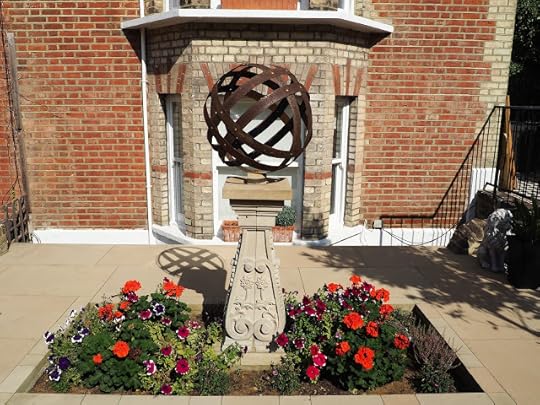
Few, if any, of the group knew what an armillary sphere was, and none of them seemed interested. Probably best to stick to the Blue plaques.
May 14, 2024
SOME BALLARDIAN WALKS

‘Towards evening, when the great shadow of the Palladian villa filled the terrace, Count Axel left his library and walked down the wide rococo steps along the time flowers.’
These are the first words I ever read by JG Ballard. They’re the opening of ‘The Garden of Time,’ a short story which I read in Introducing SF: A Science Fiction Anthology, edited by Brian W Aldiss, published by Faber. I was 12 or 13 years old at the time and it would be at least a decade before I read anything else by Ballard but it stayed with me, and when I read Crash and The Atrocity Exhibition, it suddenly clicked, oh OK, these are by THAT guy.
There’s a certain amount of walking in ‘The Garden of Time.’ The Count and has a lovely harpsichord-playing wife strolling about the grounds, while beyond the estate’s wall there’s an undulating plain across which a great rabble is advancing on the villa. The Count walks among the ‘time flowers,’ plucks one of them and the mob is magically sent back to the horizon ‘in a reversal of time.’ But the mob is getting nearer, the time flowers are withering, and (spoiler alert) those darned working classes triumph.
The story has been on my mind, and a few other people’s too I’m sure, since the Met featured a Garden of Time themed 2024 Gala. Judging by the outfits I think it’s just possible that not all the guests sat down and assiduously studied their Ballard before making their fashion choices.



Although possibly Johnny Depp did.

However, the fact is that time gardens or gardens of time are more common than you might expect. Of course all gardens are time-based, things grow and thrive and then do or don’t die. No surprises there.
There’s a Time Garden in Charles Jencks’ Cosmic House, in Holland Park. designed by Jencks’s wife Maggie Keswick. I have actually walked there, briefly. At the rear of the garden is a mirrored door marked The Future. You look into it and you see yourself in the present. I love that.
At Colchester General Hospital there is a Time Garden, visible behind closed windows and locked doors, only accessible to a few terminally-ill patients who can spend time there with their loved ones while they still, briefly, can. There’s no Palladian villa but there is a kind of long cabin. I’ve never known how and on what basis patients get chosen to occupy the cabin.
I never imagined that Ballard was much of a gardener, and in his memorial essay Michael Moorcock says that Ballard’s back garden ‘served as a pit in which he burnt review copies,’ which seems Ballardian in way, but also sometimes it was a ‘jungle of sunflowers,’ which sounds less so, unless they were killer sunflowers. Here’s a photograph of the man himself, in his garden, by John Lawrence.
May 9, 2024
AN ORDERLY KEW

If you go to Kew Gardens by Tube you’ll probably find yourself walking from the station to the Victoria Gate entrance via Lichfield Rd, and you’ll find other people doing the same.
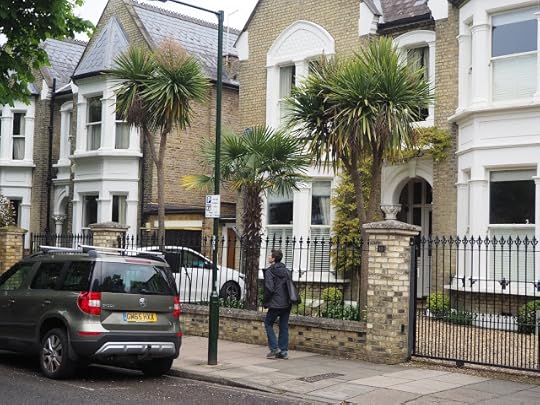
I think the inhabitants of Lichfield Road are presented with an interesting dilemma. Of course they can’t compete with the grand horticultural wonders of Kew, but they obviously think they should make a bit of an effort and so the various gardens you walk past are resplendent with topiary, palms, wisteria, bamboo, and any number of other plants I can’t identify.


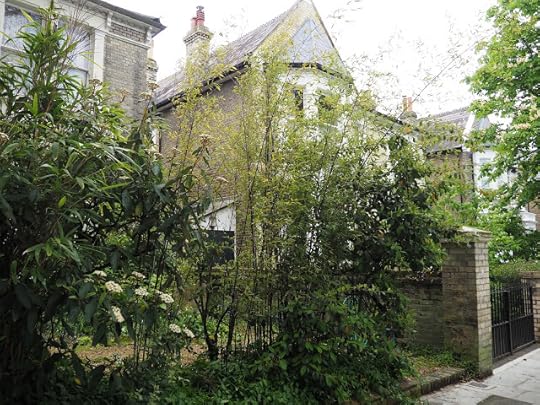
Of course walking is the chief and best way of seeing Kew Gardens, though there is a bus that will take you round, and this would seem like a very useful thing for those who are lame or old or infirm or otherwise immobilized. But staring into the carriages, they seemed to be filled with lumpen tourists who just couldn’t be arsed to walk.

But, to be fair, thousands of other visitors are made of sterner stuff – we tramped, we promenaded, we meandered, along the Broad Walk, the Princess Walk the Larch Walk, the Stafford Walk, the MInka Walk the Boat House Walk, the Camellia Walk, as well as along various other paths that didn’t have walk in their name such as the Cart Track.
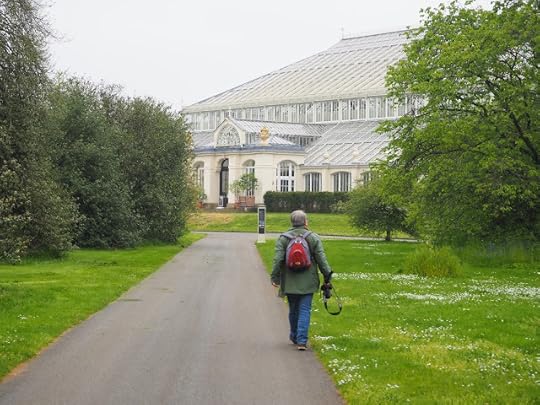

And in due course we arrived at the Japanese Gateway, part of the dry stone kaiyu shiki or if you prefer ‘stroll-around garden.’


And the fact is, strolling around is my favourite garden activity, certainly preferable to digging, weeding, muck spreading, chainsaw work etc.

The place was surrounded by artists and their work.

And of course there were a lot of white stones – which are for walking around but not for walking ON, and to hammer home the message there was this sign, a nice change from ‘keep off the grass.’

Geoff Nicholson's Blog
- Geoff Nicholson's profile
- 55 followers






